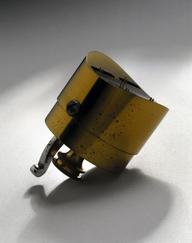

Glass ampoule of dysentery vaccine, Paris, France, 1917
- maker:
- Laboratoire de l'Armée




Ampoule of dysentery vaccine, by Laboratoire de l'Armee, French, c. 1916
This vaccine was made by Laboratoire de l'Armée (the Army Laboratory) in Paris, France in 1917. The vaccine would have been injected through the skin and was intended to provide protection against a form of dysentery known as Flexner’s dysentery. Simon Flexner (1863-1946), an American bacteriologist, identified the bacteria that caused the disease while working in the Philippines in 1899.
The vaccine would have been used to vaccinate French troops during the First World War. Preventing disease was essential to keep large numbers of troops healthy, especially when soldiers were living in close quarters.
Details
- Category:
- Public Health & Hygiene
- Collection:
- Sir Henry Wellcome's Museum Collection
- Object Number:
- A629781
- Measurements:
-
overall: 96 x 24 mm
weight: 0.305kg
weight: 0.67241lbs
- type:
- vaccine




